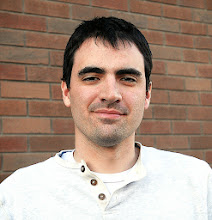Behind Enemy Lines with: Blue Jays Head of Player Development Charlie Wilson (Part 1)
 Today, I begin what I hope will be an 11-part series of conversations with the Head of Player Development (or the Mark Newman) of the rest of the Eastern League teams.
Today, I begin what I hope will be an 11-part series of conversations with the Head of Player Development (or the Mark Newman) of the rest of the Eastern League teams. I do this because I think it's kind've cool for readers to get a behind-the-scenes look at the talent in the organizations that the Thunder will face. Then again, maybe I'm the only one who thinks that's a cool idea.
In this installment, we begin with Charlie Wilson, the player development guru for the Toronto Blue Jays.
Next up, we'll have Jim Rantz of the Minnesota Twins.
(Photo, from left: Jays minor league field coordinator Doug Davis, Fisher Cats slugger Eric Thames and Wilson.)
JN: We saw a glimpse of Adeiny Hechavarria last year, and clearly that glove is very, very advanced. What did you guys see from his bat?
CW: Obviously we signed him as an amateur last year. It was the first year that Adeiny was in the United States, let alone playing professional baseball. So last year was a huge transition year in his life. It was a huge jump coming from Cuba, and traveling away from his family for the first time, not knowing any English.
To answer your question directly, we saw somebody with tremendous bat potential. We felt that this guy has a chance to hit for average and hit for a little bit of power in the future. We had our evaluators see him in the Dominican Republic last winter, and obviously they were very impressed with the glove. They were impressed with his fielding, with his throwing, but they were also convinced he could hit in the major leagues.
JN: You mentioned that transition period. What do the Blue Jays have in place to help Spanish-speaking imports learn English and communicate better in the states?
CW: Our cultural assimilation program begins in the Dominican Republic, in our facility in San Pedro de Macoris. We have English lessons every day during our instructional program down in the Dominican, and during their Dominican Summer League season.
When they come to the United States to start spring training in our extended camps, they’re receiving half an hour of English daily, sometimes in the morning, sometimes in the afternoon, depending on the time of year. The spring training classes are in the morning, extended in the evening. The Gulf Coast lessons are the in morning.
We have an on-site liaison between the team and our Latin American program and the players. That’s a gentleman by the name of Blake Bentley, whose title is Assistant of Latin American Administrations. He’s our cultural assimilation coordinator so, not only is he coordinating the English classes, but he’s on site to assist the guys with their transformation from playing in the Dominican to the United States for the first time.
The guys, if they need help in the hotel or when it’s time to go out and get an apartment on their own, they make sure they know what they’re doing. Opening up bank accounts, Social Security numbers, all that stuff when it comes to life in the United States.
Labels: Eastern League, Toronto Blue Jays, Trenton Thunder
 RSS
RSS


0 Comments:
Post a Comment
Subscribe to Post Comments [Atom]
<< Home